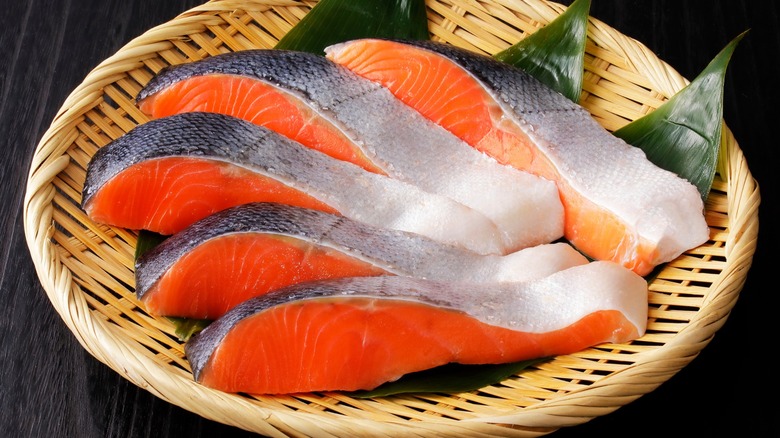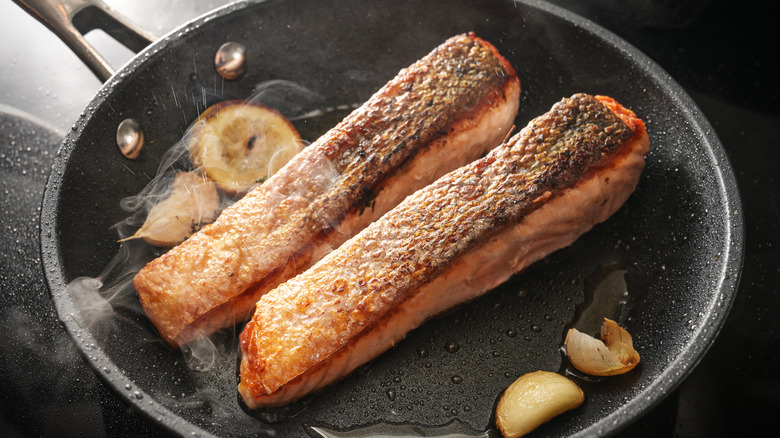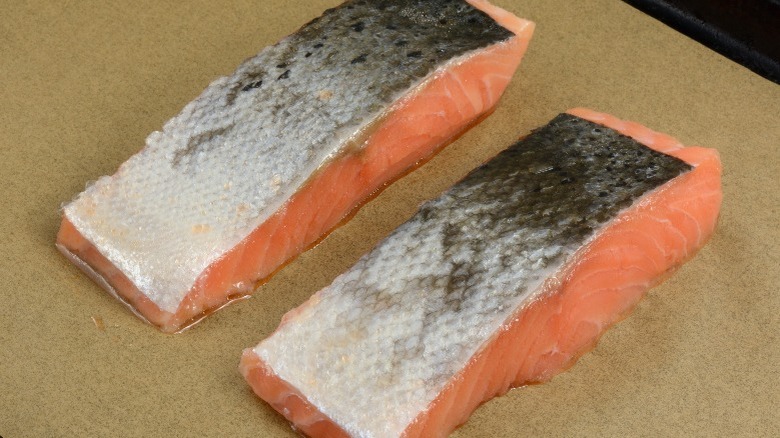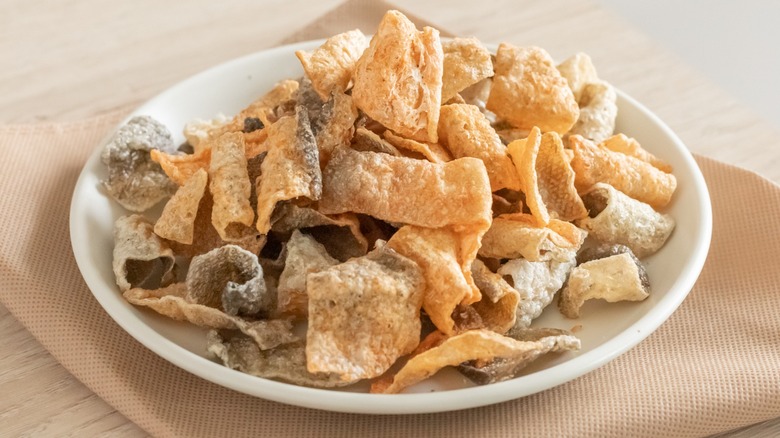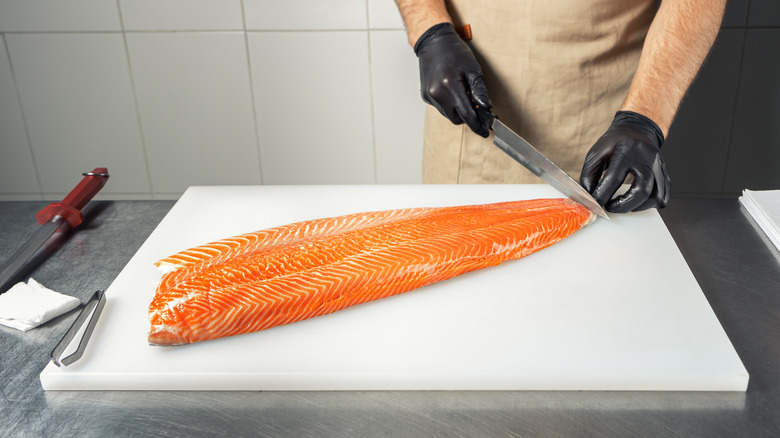Should You Eat The Skin On Salmon?
Whether or not to eat salmon skin is a rather divisive issue, with heated opinions on both sides. For some, salmon skin is just too weird, too fatty, tastes too fishy, or has an otherwise overpowering flavor. When prepared incorrectly, salmon skin can be unappetizing both visually and texturally, looking and tasting like a soggy, limp, and rubbery mess.
On the other end of the spectrum, fans of salmon skin know that it's one of the best parts of the fish, and love it for its concentrated salmon flavor. A perfectly crispy salmon skin provides a wonderfully crunchy textural contrast to the soft and flaky salmon flesh and can be a delicious snack all on its own.
Salmon skin fans also know that cooking salmon with the skin on can help keep the fish moist and provide additional nutritional benefits when compared to eating salmon without the skin. Assuming you can prepare the salmon skin correctly, and with just a few caveats, you should eschew this common myth about salmon and absolutely eat the skin.
Nutritional information about salmon skin
One of the main health benefits of eating salmon is that it's a good source of omega-3 fatty acids, which our bodies cannot produce on their own, and which may help with heart, brain, skin, and eye health. Turns out, salmon skin contains the highest concentration of omega-3s in the entire fish, and cooking salmon with the skin on helps retain oils and nutrients that would otherwise be lost.
Salmon skin is also a good source of protein, vitamins B and D, collagen, and essential minerals like selenium. Recent studies also suggest that salmon skin may offer antioxidant benefits that help in the treatment of type-2 diabetes and in the prevention of cancer. Still, there are some concerns to be aware of when it comes to eating salmon skin. Fish, including salmon, can easily absorb pollutants from the water. Of particular concern are polychlorinated biphenyls (PCBs) and methylmercury, which have been linked to cancer and birth defects.
If you're not confident that your salmon comes from clean waters, it may be best to skip the skin, especially for those in a sensitive group like pregnant and nursing women and young children. Farmed salmon has been found to contain more toxins than wild salmon, with Atlantic farmed salmon generally considered to be the most contaminated and wild-caught Pacific salmon the safest.
How to cook salmon skin
The proper way to serve salmon skin is crispy, which can only be achieved by certain cooking methods, such as frying, grilling, and searing. Before cooking, it's critical to remove as much of the moisture from the skin as possible. Otherwise, the excess moisture will cause the salmon skin to steam rather than crisp up when cooked. You should always pat your salmon dry with a paper towel and bring it up to room temperature before cooking it, but there are a few other tricks to get it extra dry.
Chef Thomas Keller recommends "drawing a knife blade firmly back and forth over the fish, the way a wiper blade moves across a windshield" (via the L.A. Times); Recipetineats likes to place the salmon skin-side up in the fridge for an hour to get it extra dry before cooking; and Chef Emma Bengtsson uses a multi-step process that involves seasoning the salmon with a 50-50 mix of salt and sugar, letting it chill in the fridge for a few hours before washing off the rub with water, and returning the salmon, skin-side up, to the fridge overnight to further dry out the skin.
How to get salmon skin extra crispy and keep it that way
For extra crispy skin, you should always cook the salmon skin-side down. Use a really hot pan, and an oil with a high smoking point to cook your salmon, but be careful that your oil isn't so hot that it's smoking, chef Thomas Keller warned in the L.A. Times. Once your salmon has gone in the pan, reduce the heat to medium and leave it alone until the fat has rendered out of the skin, making it nice and crispy.
The salmon should also release easily from the pan at this point. Flip it to the other side briefly to finish cooking. You can also sear the salmon in a pan and finish it in the oven. Even if you manage to cook salmon with perfectly crispy skin, you can still ruin that crispiness by serving it wrong, such as by serving the salmon skin-side down over a portion of pasta or purée, so remember to always serve salmon skin side up to keep it crispy from pan to plate.
Eating salmon skin on its own
Although salmon skin is delicious when left on the fish, it can be enjoyed on its own as well, either inside a sushi roll or as a salad topping or garnish — Chef Nyesha Arrington likes to serve crispy salmon skin chips as a sustainable garnish to her confit salmon. One option is to fry strips of salmon skin in oil so it becomes salmon bacon (similar to pork rinds). Another option is to bake the skin until it's crispy.
If you do end up removing the salmon skin to make salmon bacon or otherwise, you should consider poaching the rest of the salmon, since poaching is a gentler process that won't dry the skin-less salmon out. Poaching will also lead to an unpleasant skin texture, so you should remove the skin before serving regardless if you plan to poach your salmon. You should also remove the frozen fish's skin if you're planning to cook a piece of frozen salmon as it simply won't crisp up after thawing.
How to remove salmon skin
To remove the skin, place your salmon skin side down on a secured cutting board — try placing a wet paper towel underneath the board so it won't move around. Using a boning knife or a sharp chef's knife, cut between the flesh and the skin at one corner (or at the tailpiece if you have one) until you have a large enough corner of skin to grab onto. You can also cut from the top of the salmon toward the skin at an angle to give yourself a chunk to hold.
Use a paper towel or kitchen towel, or coat the corner with salt, so you have a good grip, then tug the skin in the opposite direction of the knife blade, as you continue to cut through the salmon until you've fully separated the skin from the flesh. To avoid cutting too much flesh off, some people prefer using a duller knife or even their hands after the initial cut.
Alternatively, use the boiling water hack that makes skinning salmon a breeze. To do this, place salmon filets with the skin-side up on a mesh rack with a pan underneath, then slowly pour boiling water over the filets; the hot water will cause the skin to soften and curl away from the flesh, making it easy to peel off. You can also wait until your salmon is cooked before attempting to remove the skin — in this case, spatulas are the perfect tool for removing the fish skin.
